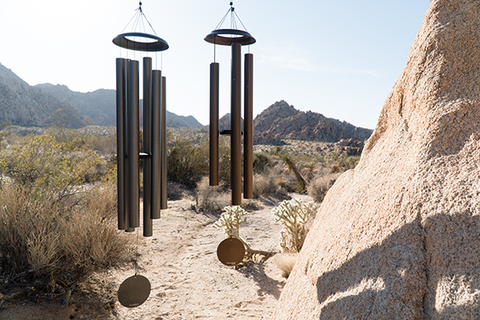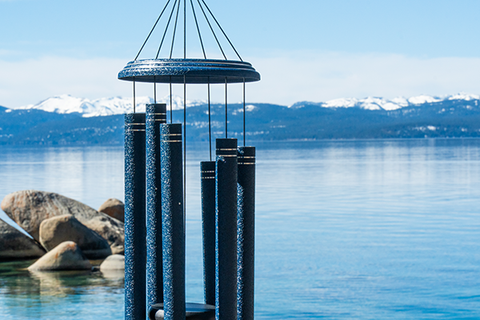
Introduction
Wind chimes come in a variety of tones, from deep, resonant melodies to light, sparkling notes. But what exactly determines the sound of a wind chime? Whether you love the soothing, meditative tones of a Wind River chime or the soft, natural tones of bamboo wind chimes, understanding the factors behind their unique sounds can help you choose the perfect chime for your space.
In this article, we explore the science and craftsmanship behind wind chimes and how different elements influence their musical quality.
See Also: How Wind River Chimes Differ From Other Chimes
- Material: The Heart of the Sound
- Tube Length & Thickness: The Science of Pitch
- Tuning: The Art of Musical Precision
- Striker Position: Hitting the Right Note
- Wind Sail Size: The Frequency of Chiming
- Placement: How Wind Affects Sound
- Popular Wind Chimes and Their Signature Sounds
- Frequently Asked Questions
- Conclusion
1. Material: The Heart of the Sound
Different materials produce distinct sounds due to their density, resonance, and ability to sustain vibrations. Here’s how common materials affect sound:
- Aluminum: Produces clear, resonant, and long-lasting tones. Often used in premium chimes like Wind River chimes, who makes Corinthian Bells, Arabesque, and Shenandoah Melodies.
- Bamboo/Wood: Creates soft, organic, and percussive sounds, making it ideal for a natural, Zen-like ambiance.
- Glass: Delicate and high-pitched, glass chimes produce a sparkling, ethereal sound.
- Steel, Brass & Copper: Used in bell-style chimes, these metals offer a deep, spiritual resonance.
- Ceramic & Shells: Softer and muted tones, often decorative and artistic.
2. Tube Length & Thickness: The Science of Pitch
- Longer tubes = Deeper sounds (e.g., a 50-inch Corinthian Bells wind chime has a rich, bass-like resonance).
- Shorter tubes = Higher-pitched tones (e.g., small Festival chimes made by Wind River Chimes produce bright, playful sounds).
- Thicker tubes sustain sound longer, while thinner tubes create a sharper tone.
3. Tuning: The Art of Musical Precision
High-quality chimes are often hand-tuned to specific musical scales, ensuring harmony. Common tunings include:
- Pentatonic Scale: Found in most wind chimes, providing universally pleasing melodies.
- Major Scale: Bright, uplifting notes.
- Minor Scale: Deep, moody, and soothing tones.
- Custom Tunings: Some chimes, like Wind River’s Eclipse Chimes, are tuned to the Lydian mode, producing a unique, ethereal harmony.
4. Striker Position: Hitting the Right Note
The striker (clapper), is the center piece of the wind chime that strikes the pipes to produce the sound. This piece is usually made of wood, metal, or another resonant material. In the case of a Wind River chimes, many of strikers are made of high-density polymer which elicits a pure, crisp note and warm tone.
The striker plays a crucial role in sound production.
- Light striker: More soft, subtle sounds.
- Heavy striker: Stronger, clearer, and more resonant tones.
- Adjustable strikers allow you to control the volume.
5. Wind Sail Size: The Frequency of Chiming
The wind sail (or catcher) is the piece hanging below the chimes, attached to the striker. It captures the wind's force, moving the striker to produce sound.
- Larger wind sails: Capture more wind and increase chime activity.
- Smaller wind sails: Require stronger winds to produce sound, making them more sporadic.
6. Placement: How Wind Affects Sound
Where you hang your wind chime impacts how often it plays and how it sounds:
- Open, breezy areas: Ensures frequent, melodic chimes.
- Sheltered patios or porches: Produces gentler, occasional tones.
- Indoors near windows: Allows chimes to move with a breeze coming in through the window.
Popular Wind Chimes and Their Signature Sounds
Here are some well-known wind chime brands and how they sound:
- Corinthian Bells from Wind River Chimes: Rich, deep, and long-lasting tones.
- Shenandoah Melodies from Wind River Chimes: Balanced, mellow sound.
- Festival Chimes from Wind River Chimes: Bright, cheerful notes.
- Memorial Wind Chimes: A variety of tones and engravings for remembrance.
- Bamboo Chimes: Natural, earthy percussion for Zen settings.
Frequently Asked Questions About Wind Chime Acoustics
Q: Why do some wind chimes sound deeper than others?
Larger, thicker tubes and lower musical tunings create deeper sounds. Corinthian Bells wind chimes, for example, are designed for deep, resonant tones.
Q: Which wind chime is best for a soothing, meditative environment?
Chimes tuned to a pentatonic scale or those made from aluminum provide the most calming effects.
Q: Can I change the sound of my wind chime?
Yes! Adjusting the striker position or wind sail size can alter how often and how forcefully your chime sounds.
Conclusion
Wind chimes are more than just decorative pieces—they are carefully crafted musical instruments that bring peace, relaxation, and joy to any space. By understanding the factors that influence their sound, you can select the perfect wind chime that resonates with your environment and personal taste.


